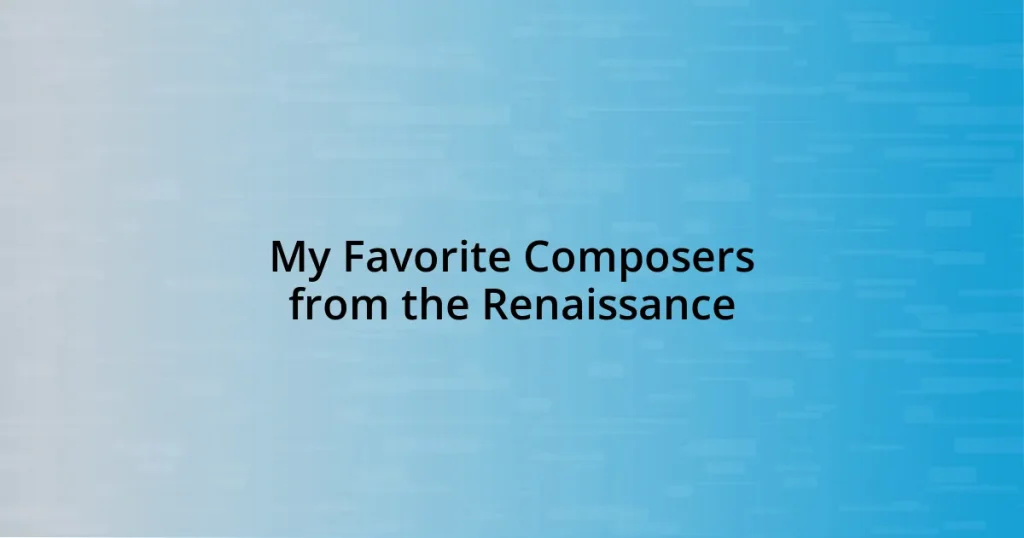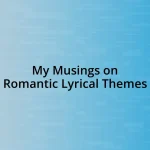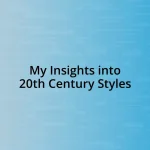Key takeaways:
- The Renaissance (14th-17th century) was a period of revival in art, literature, and music, transitioning from religious to humanist themes.
- Key musical developments included the popularization of polyphony, the emergence of secular music, and a focus on text clarity for emotional expression.
- Influential composers such as Josquin des Prez, Palestrina, and Monteverdi shaped the musical landscape, leaving a lasting impact on both sacred and secular music.
- Analyzing Renaissance compositions involves exploring texture, phrasing, and historical context to grasp the depth and meaning of the music.
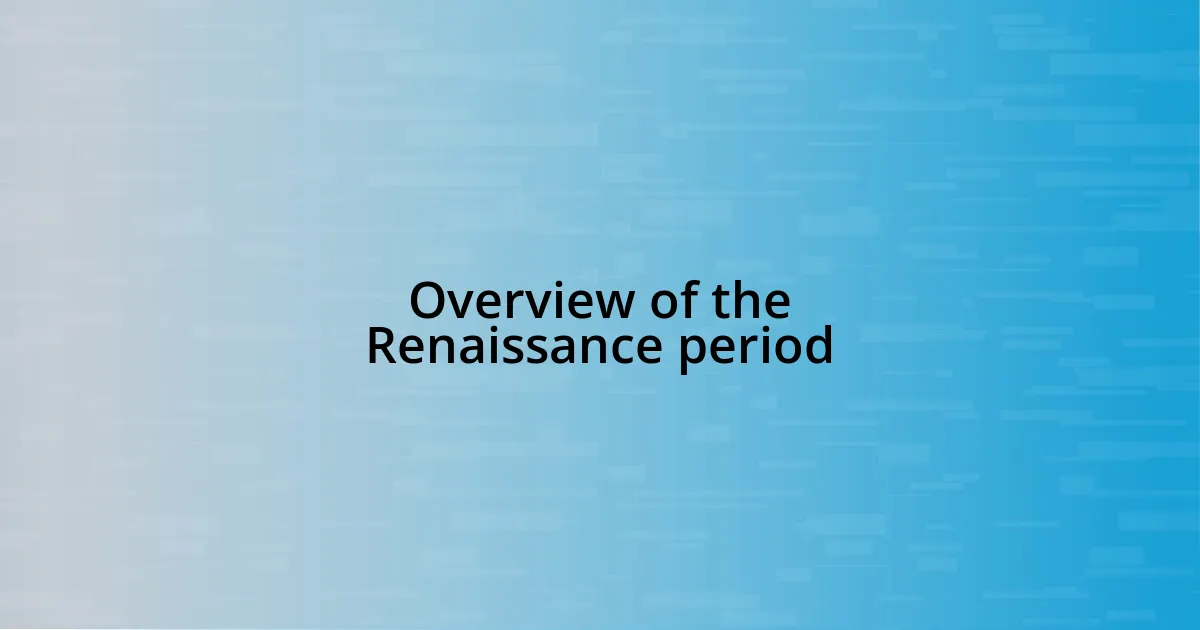
Overview of the Renaissance period
The Renaissance period, spanning roughly from the 14th to the 17th century, marked a remarkable revival of interest in art, literature, and science in Europe. I often think of this era as a bridge, connecting the medieval past with the modern world. Isn’t it fascinating how individuals like Leonardo da Vinci and Michelangelo not only shaped the art world but also influenced scientific inquiry and humanistic thought?
During this time, the focus shifted from purely religious themes to exploring human emotion and the beauty of the natural world. I remember reading about the passionate sonnets of Petrarch, which felt so alive and personal to me—they captured love and longing in such an accessible way. This shift in perspective began to lay the groundwork for individual expression, encouraging audiences to appreciate not just the subject but also the artist’s unique voice.
Musically, the Renaissance brought about significant changes, with polyphony—multiple independent melodies sung or played simultaneously—gaining popularity. It’s incredible to think about how composers like Josquin des Prez and Palestrina experimented with these techniques, leading to a richer, more complex sound. Have you ever listened to a piece from this period and felt carried away by its depth? I know I have, and it always leaves me in awe of how art and music can reflect the spirit of their time.
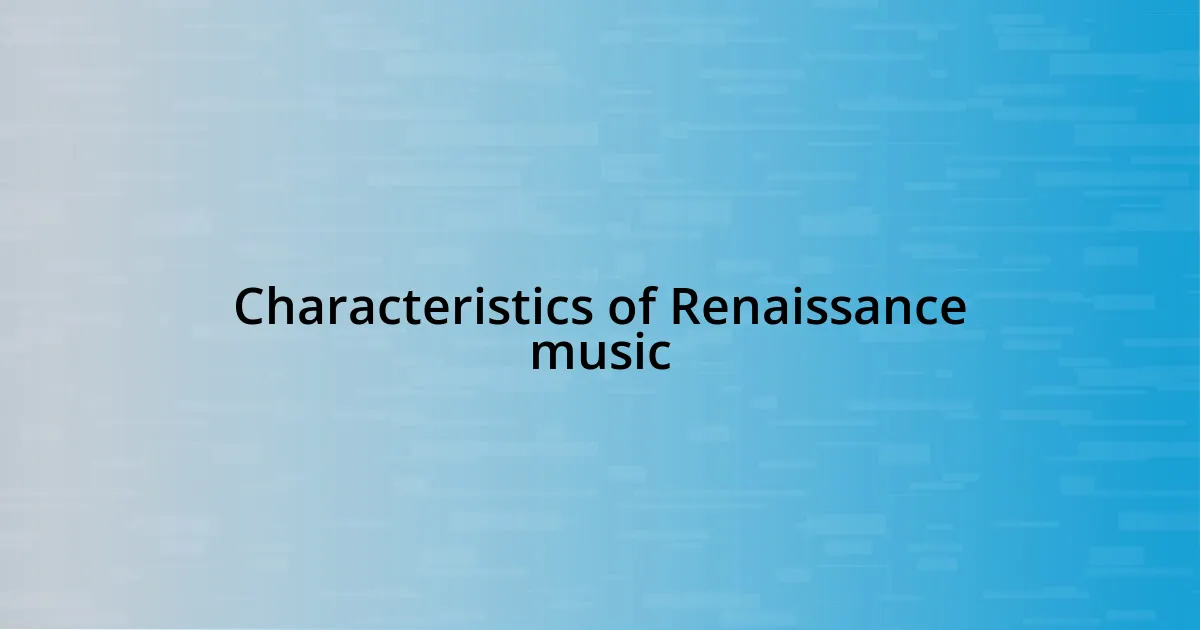
Characteristics of Renaissance music
The Renaissance music scene is characterized by its embrace of harmony and the use of polyphony. Composers began to intertwine multiple vocal lines, creating a tapestry of sound that evokes a sense of balance and beauty. I remember the first time I heard a piece by Palestrina; it felt like each voice was conversing, weaving a narrative that sucked me right into the moment.
Another fascinating aspect of this period was the emergence of secular music alongside sacred compositions. Songs explored themes of love, nature, and human experience, reflecting a broader range of emotions. I often find myself humming tunes from this era, captivated by how they capture the complexities of life in just a few notes. It’s almost as if these melodies are a reflection of the human experience, inviting us to join in their journey.
Renaissance music also placed significant importance on the clarity of text and expressive lyrics. Composers aimed to ensure that lyrics were easily understood, allowing the emotional content to resonate with listeners. When I sing along to these pieces, I can feel the connection between the words and the music, almost as if the composers were speaking directly to me. This intentionality gives a voice to each emotion, making the beauty of Renaissance music even more impactful.
| Characteristic | Description |
|---|---|
| Polyphony | Multiple independent melodies sung or played simultaneously. |
| Secular vs. Sacred | Emergence of songs exploring non-religious themes alongside traditional sacred music. |
| Clarity of Text | Focus on clear lyrics to enhance emotional expression and audience connection. |
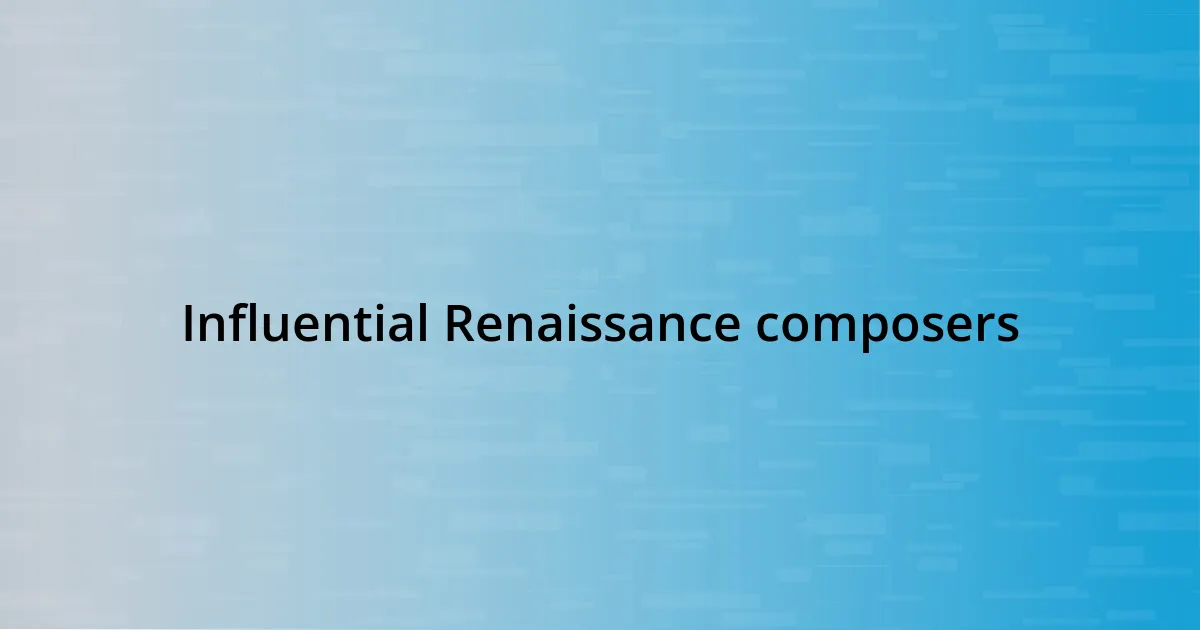
Influential Renaissance composers
The Renaissance era gave rise to a remarkable array of influential composers who left indelible marks on the musical landscape. One such figure is Josquin des Prez, whose mastery of polyphony still resonates with listeners today. I vividly recall discovering Josquin’s “Miserere mei, Deus” during a late-night study session; the way the harmonies intertwined felt like a glimmer of divine light cutting through the darkness. His innovative techniques influenced many composers, and the emotional depth he achieved continues to inspire singers and musicians.
Another pivotal composer, Giovanni Pierluigi da Palestrina, is often regarded as the cornerstone of Renaissance sacred music. I remember attending a choral concert where his “Sicut cervus” was performed; the ethereal quality of the voices blending seamlessly transported me to a place of profound peace. Palestrina’s focus on clarity in text and rhythmic motion made his works not only accessible but deeply affective as well.
Here are a few influential composers from the Renaissance period:
- Josquin des Prez: Known for his intricate use of polyphony and emotional expression.
- Giovanni Pierluigi da Palestrina: Celebrated for his sacred music and clarity of text.
- Thomas Tallis: Recognized for his choral works that bridged the religious and the political landscapes of his time.
- Orlando di Lasso: Famous for his diverse compositions and mastery of various musical styles across Europe.
- Claudio Monteverdi: Creator of early operas and instrumental music, blending Renaissance and Baroque styles.
These composers not only provided a soundtrack for the Renaissance but also laid the groundwork for future generations to expand on their innovative ideas, shaping the course of Western music history.
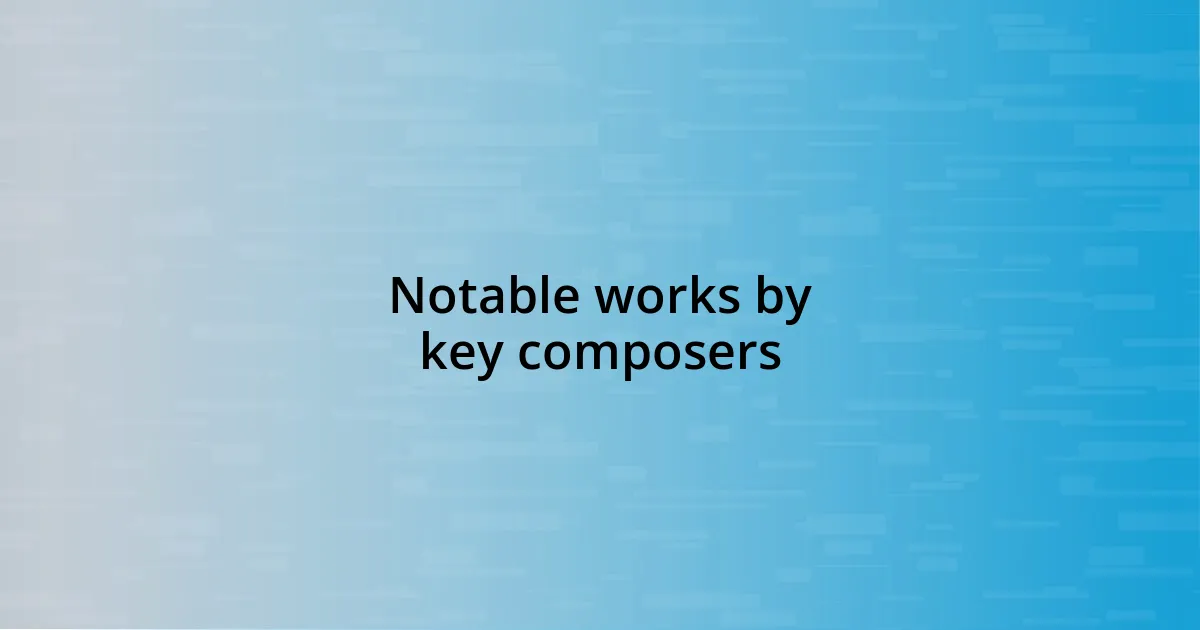
Notable works by key composers
Josquin des Prez truly stands out for his extraordinary work, particularly his “El Grillo” (“The Cricket”). It’s such a delightful piece that captures the essence of carefree summer days. I recall listening to it while lounging in my backyard—its playful rhythms made the whole afternoon feel like a whimsical escape. The way Josquin layers voices allows each nuance to shine, almost as if the cricket itself were singing a joyful tune right alongside the ensemble.
Claudio Monteverdi is another composer whose works have deeply resonated with me. His “Vespers of 1610” is a breathtaking blend of sacred music that feels both majestic and intimate. I remember being enchanted during a live performance, where the echoes of the choir in the cathedral merged with the intricate instrumentation. That moment made me reflect on how Monteverdi brilliantly transitioned Renaissance music into the beginnings of the Baroque style, capturing the evolving spirit of his time. Have you ever felt transported by music to another era? That’s exactly how his Vespers made me feel.
Then there’s Thomas Tallis, whose “Spem in alium” never ceases to amaze me with its complex, 40-part choral texture. The first time I heard it, I was completely overwhelmed by the sheer magnitude of sound. How could so many voices blend seamlessly yet still maintain their individuality? It left me pondering the possibilities of collective expression in music—Tallis masterfully utilized every voice to create a rich tapestry that envelops the listener, inviting us into a space of reverence and awe. The experience truly illustrated the beauty of Renaissance music’s ability to connect us, much like the harmonious gathering of a community.
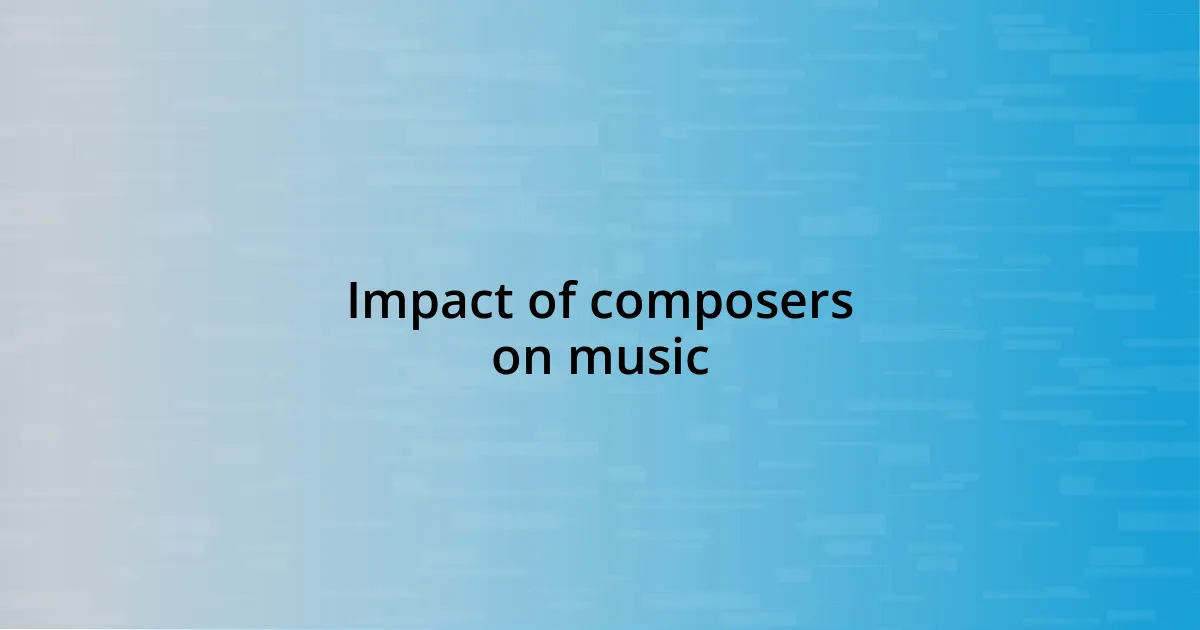
Impact of composers on music
The influence of Renaissance composers on the music of their time and beyond is striking. I remember grappling with the intricate harmonic progressions in Josquin’s works while trying to replicate them on the piano. It was a humbling experience, realizing that these techniques, which felt almost magical, became the foundation for countless composers who followed. Like a pebble tossed into a pond, their innovations created ripples that continue to shape music today.
When I think about Palestrina, I can’t help but remember how his compositions aim to draw the listener into a meditative space. One evening, I found myself enthralled by a recording of “Missa Papae Marcelli,” feeling the calming wave of unity from the choral voices. Palestrina’s ability to balance complexity with clarity influenced generations of composers in both sacred and secular music, showcasing how intentionality in composition can create a profoundly emotional experience.
Then there’s Monteverdi, a name that evokes a sense of adventure in musical evolution. His journey from the Renaissance into the Baroque era fascinates me. I once attended an opera featuring his music, and the seamless transition from vocal passion to orchestral flourishes captivated my imagination. How did he conceive such brilliant harmonies that felt both grounded in the past yet on the brink of something entirely new? Monteverdi’s work invites musicians and listeners alike to explore the limitless possibilities of expression, urging every generation to push boundaries in their own creative endeavors.
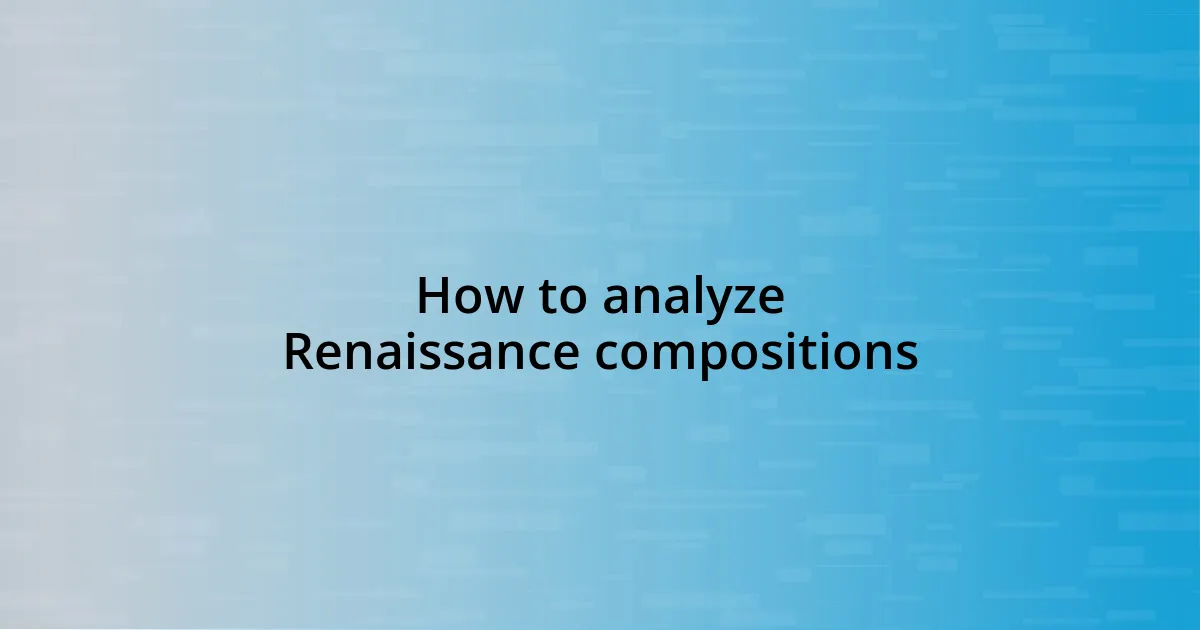
How to analyze Renaissance compositions
When analyzing Renaissance compositions, it’s essential to dive into the layers of texture and harmony that define this era. I vividly recall the first time I was immersed in the intricate vocal lines of an early choral work. Trying to follow each part simultaneously felt like unraveling a beautifully woven tapestry, revealing how the interplay of voices creates a rich, unified sound. This complexity isn’t just an academic concept; it’s a thrilling experience that enhances your appreciation of the music.
Listening closely to the phrasing is another crucial aspect of analysis. For instance, while studying a piece by Tallis, I found myself caught up in the conversational quality of the music. Certain phrases seemed to ask questions while others provided answers, almost like a dialogue between the voices. It made me ponder: how does this interplay affect the overall emotional impact of the piece? Recognizing these nuances is key to understanding not only the composer’s intentions but also the feelings they aimed to evoke in their audience.
Furthermore, examining the historical context around a composition can reveal profound insights into its meaning. I remember exploring how the sacred nature of Palestrina’s works reflected the religious fervor of the time. Connecting these dots opened my eyes to how composers conveyed their beliefs through their music. Isn’t it fascinating how art can serve as a lens into society’s soul? By combining these perspectives—texture, phrasing, and context—you can develop a deeper, more fulfilling understanding of Renaissance music and the stories it tells.

Recommendations for further listening
Exploring more music from the Renaissance era can be a delightful journey. I remember stumbling upon a collection of Thomas Tallis’ motets, and it felt like a revelation. The way his harmonies unfold is akin to watching colors blend together on a canvas. If you haven’t yet listened to “Spem in alium,” I highly encourage you to do so. It’s a stunning display of choral richness that can easily make you pause and reflect on the power of collective voices.
I find that delving into the works of Claudio Monteverdi offers a refreshing taste of innovation amid traditional frameworks. One night, I found myself lost in his Vespers of 1610. The interplay between bright, vibrant melodies and profound emotional depth struck me like a lightning bolt. It raises an interesting question: How does music manage to bridge centuries while still feeling incredibly relevant? I believe Monteverdi serves as a wonderful example of that timeless connection.
For anyone intrigued by the sacred music of the Renaissance, I strongly suggest listening to Giovanni Gabrieli’s compositions. While revisiting his Sacrae Symphoniae, I was amazed by the spatial dynamics he employed, which made me feel as though I was stepping into St. Mark’s Basilica. Have you ever experienced music that felt as if it wrapped around you? Gabrieli’s innovative use of echo in his music invites listeners into a sacred space where sound itself becomes a physical entity, enhancing the divine themes present in his work.











